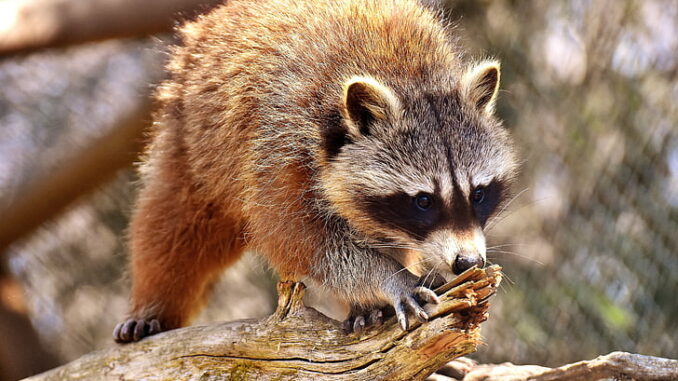
Curiosity often arises about the dietary habits of raccoons, and a common question is, “Do raccoons eat dead animals?” Raccoons are known to eat dead animals as they are opportunistic omnivores that include carrion in their diet, but there are potential concerns due to disease transmission, parasites, and the risk of attracting other wildlife.
In this brief exploration, we’ll delve into the intriguing world of raccoon dining habits, shedding light on whether they indulge in the consumption of deceased wildlife and the reasons behind such behavior.
Table of Contents
Do Raccoons Eat Dead Animals?
Yes, raccoons are known to include dead animals in their diet. As omnivores, they showcase a highly opportunistic eating behavior, thriving in diverse environments. In their natural habitat, raccoons consume a variety of foods, such as fruits, nuts, insects, small mammals, birds, and aquatic life.
Their adaptive nature enables them to navigate urban landscapes where they readily forage through garbage bins and consume discarded human food.
In their role as scavengers, raccoons incorporate dead animals into their diet. This scavenging behavior serves as a survival strategy, allowing raccoons to capitalize on available food resources, including the remains of animals encountered in the wild or urban environments.
Table: Examples of Raccoon Diets
| Food Source | Description | Importance |
| Fruits and Veggies | Raccoons consume a variety of fruits and vegetables. | Essential for vitamins and dietary balance. |
| Insects | Insects form a significant part of a raccoon’s diet. | Protein-rich and aids in overall nutrition. |
| Small Animals | Raccoons may prey on small animals like rodents. | A source of protein and necessary nutrients. |
| Carrion | Consuming dead animals (carrion) is observed. | Provides additional protein in the diet. |
Why do Raccoons Eat Dead Animals?
Understanding the motivations behind raccoons consuming dead animals sheds light on their ecological role and survival strategies.
- Scavenging Instincts: Raccoons are opportunistic scavengers, utilizing their keen sense of smell to locate and consume carrion when available.
- Ecological Cleanup: Consuming dead animals contributes to the ecosystem’s balance, as raccoons play a role in decomposing and recycling organic matter.
- Adaptability: Raccoons’ omnivorous and adaptive nature enables them to incorporate a range of food sources, including carrion, to meet their nutritional needs.
- Survival Strategy: In both natural and urban environments, scavenging on dead animals serves as a supplemental food source, enhancing their chances of survival.
- Availability of Resources: Raccoons opportunistically eat dead animals when live prey is scarce, showcasing their ability to capitalize on diverse food resources.
Dangers of raccoons eating dead animals
While raccoons’ scavenging habits play a role in the ecosystem, there are potential dangers associated with their consumption of dead animals.
- Disease Transmission: Raccoons can become carriers of diseases present in the carcasses they consume, posing a risk to both wildlife and domestic animals.
- Traffic Hazards: Their attraction to roadkill increases the likelihood of raccoons being near roads, exposing them to the dangers of traffic and potential accidents.
- Human Health Concerns: Proximity to areas with dead animals can bring raccoons into contact with human habitats, raising concerns about disease transmission and conflicts with pets.
- Predator Attraction: The scent of carrion may attract larger predators, potentially leading to confrontations and territorial disputes in shared habitats.
- Environmental Impact: Overreliance on scavenging dead animals may disrupt natural ecosystems by altering scavenger-predator dynamics and nutrient cycling.
Frequently Asked Questions (FAQs) About Raccoons Eating Dead Animals
Q1: Do raccoons eat dead animals as a primary part of their diet?
A: No, raccoons primarily rely on a diverse diet that includes live prey, fruits, and vegetables. While they are opportunistic scavengers, carrion is not their main food source.
Q2: Why do raccoons include dead animals in their diet?
A: Raccoons are opportunistic eaters, and including dead animals in their diet serves as a survival strategy. It allows them to capitalize on available food resources, especially when live prey or other food sources are scarce.
Q3: Is there anything to worry about raccoons eating dead animals considering potential dangers?
A: Yes, there are concerns associated with raccoons consuming dead animals. They can become carriers of diseases present in carcasses, posing risks to both wildlife and domestic animals. Additionally, their attraction to roadkill increases the likelihood of traffic hazards and potential accidents.
Q4: How does the consumption of dead animals contribute to the ecosystem?
A: Raccoons play a role in the ecosystem by assisting in the decomposition and recycling of organic matter. Consuming dead animals contributes to the balance of the ecosystem by recycling nutrients.
Q5: How can I stay safe from the potential dangers associated with raccoons eating dead animals?
A: To minimize risks, avoid direct contact with raccoons and their potential food sources, including carcasses. Secure garbage bins with tight-fitting lids to discourage scavenging, and promptly remove any dead animals from your property. If you encounter raccoons or their feeding areas, maintain a safe distance and refrain from feeding them, reducing the likelihood of them becoming accustomed to human interaction. Additionally, practicing good hygiene, such as washing hands thoroughly after handling waste or being in raccoon-prone areas, can further reduce the risk of disease transmission.
Conclusion
The omnivorous and opportunistic nature of raccoons extends to their occasional consumption of dead animals, showcasing their adaptability in diverse environments. While scavenging serves ecological roles, it comes with potential dangers, such as disease transmission and increased proximity to human habitats. Balancing appreciation for these resourceful creatures with awareness of potential hazards ensures a harmonious interaction between raccoons and human environments.
